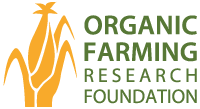Gordon’s Policy Corner, February 2025
Organic agriculture is not just a method for growing our food and fiber, it is a proven solution to many of the challenges facing U.S. agriculture today. It reduces dependence on imported synthetic inputs, strengthens rural and urban economies, and builds resilience to a changing climate through supporting healthy soils and agroecological systems. But, despite its rapid growth and growing importance, public investment in organic agriculture programs has not kept pace.
At the Organic Farming Research Foundation (OFRF), we believe that strategic, science-based policies can unlock the full potential of organic farming. That is why we have developed a new set of Policy Priorities designed to align research investments with market opportunities, enhance technical and financial assistance for organic farmers and farmworkers, and strengthen the incentive structures that reward sustainable stewardship of our natural, social, and economic resources.
By embracing these policies, Congress and the USDA can ensure that organic agriculture continues to be a thriving part of the United States’ food system; creating economic opportunities, empowering producers, and delivering environmental benefits far beyond the farm.
Bridging the Research Investment Gap to Drive Innovation and Resilience
Organic agriculture is the fastest-growing sector in the United States’ food market, accounting for over 6% of total food sales and 15% of all produce sales. Despite this growth, organic research receives less than 2% of USDA’s research funding, and less than 1% of the Agricultural Research Service’s research budget. Simultaneously, public agricultural research funding has declined by 20% since 2000, even though every $1 invested generates over $20 in economic benefits. Private funding has attempted to fill this gap, but it often prioritizes proprietary technologies over public welfare.
This underinvestment slows the ability of U.S. farmers to keep up with demand, increasing our national reliance on imported organic goods and products. Public research funding is vital to closing the domestic supply gap and ensuring that communities across the United States benefit from the economic growth of the organic sector. Increasing federal investments in organic agriculture research will drive innovation, improve resilience to agronomic and economic disruptions, and ensure U.S. farmers have access to high quality science-backed tools.
Key Policy Solutions:
- Establish an Organic Research Coordinator at the USDA
- Expand ARS Intramural Research on Organic Systems
- Strengthen NIFA Competitive Grant Programs for Organic Research
- Improve Organic Market Data Collection and Dissemination
Ensuring Farmers Get the Support They Need
The USDA alongside state and local governments offer a range of financial and technical assistance programs for farmers, but many organic farmers struggle to access these resources. There are multiple, related, reasons for this, from a general lack of awareness, administrative barriers, or insufficient organic knowledge among USDA field staff. These must be addressed to ensure organic farmers receive the support they deserve.
Many agricultural service providers, from NRCS conservation planners to private Technical Service Providers (TSPs) lack training and knowledge of organic systems, leading to guidance and advice that might not be practical or relevant for an organic farmer. Simultaneously, many organic farmers are not aware of the USDA resources available to them, leading to them missing out on key financial and technical support.
Key Policy Solutions:
- Increase Organic Knowledge Among Technical Service Providers
- Improve Outreach to Organic Farmers about Available Programs
- Expand Organic-Focused services at USDA Agencies
Understanding Organic’s Role as an Economic Engine
Organic agriculture isn’t just good for farmers and farmworkers, it’s a powerful economic engine for rural and urban communities. Research shows that regions with high levels of organic production, known as “organic hotspots,” have higher household incomes, and lower poverty rates compared to regions with lower levels of organic production. Importantly, this research shows that organic agriculture generates wealth in these areas through a variety of methods, like local capital cycling and decreased reliance on imported inputs.
A significant limiter on this economic engine is the lack of organic supply chains and connections to markets. Investing in organic infrastructure and market development will help U.S. farmers capture more of the organic market’s economic value.
Key Policy Solutions:
- Expand Funding for Organic Market Development
- Support Research on the Economic Benefits of Organic Agriculture
- Develop Policies that Recognize Organic’s Environmental and Social Benefits
Moving Forward With a Bold Vision for Organic Agriculture
Organic farming systems provide economic, environmental, and social benefits that impact entire communities. But to fully realize the organic method’s potential, Congress and the USDA must take action: investing in research, strengthening farmer technical and financial support, and ensuring organic agriculture remains a competitive and viable option for agricultural businesses across the country.
At OFRF, we are committed to advocating for policies that advance organic agriculture, support producers, and strengthen the entire food system. With the right investments, organic can continue to blaze the trail and foster economic opportunity, environmental resilience, and a healthier food system for all.
We invite policymakers, farmers, farmworkers, and the general public to join us in pushing for these critical investments in organic agriculture. The future of farming depends on it.
Stay engaged, stay informed, and together we can make a difference.
Eat well and breathe deeply,
Gordon



